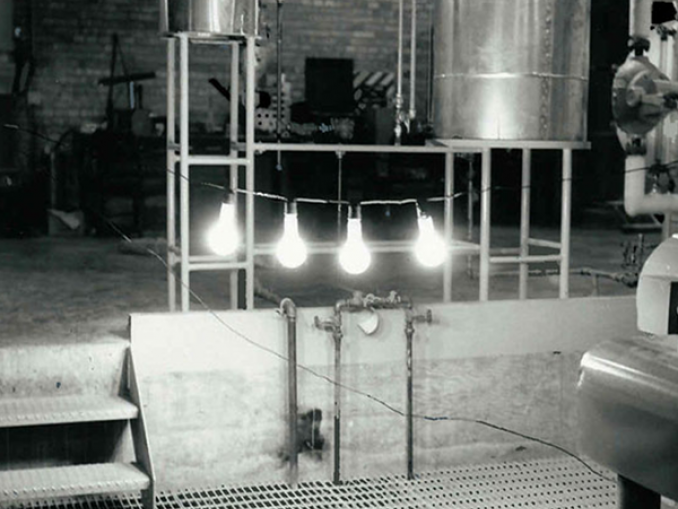Science
Related: About this forumThe legacy of Experimental Breeder Reactor-I
From my news feed:
The legacy of Experimental Breeder Reactor-I
Registration may be required.

The caption:
Excerpts:
As you drive across the Snake River Plain in southeastern Idaho along Highway 20, you are surrounded by the vast 890-square-mile Idaho National Laboratory complex, formerly the National Reactor Test Station. Other than the three large buttes formed by volcanic activity thousands of years ago, the landscape is featureless. The relatively untouched stretch is not indicative of the years of nuclear research that have taken place in this vast plain. It is here that the peaceful potential of nuclear energy was realized, fostered, and continues to be developed. It is here, too, that Experimental Breeder Reactor number 1 (EBR-I) was constructed and became the world’s first reactor to produce usable electricity.
Approaching EBR-I, you realize it is much different than today’s pressurized water reactor and boiling water reactor nuclear power plants. EBR-I is housed in a simple brick building. As you enter the building, which holds the control room, reactor, generator, and the balance-of-plant equipment, it is evident that this truly was the beginning...
...A short walk from the control room and you are standing above the reactor, peering down through the reactor vessel shield to the reactor head. On display behind you is an example of one of the 84 uranium-238 bricks used to build the neutron reflector/shield, known as the breeder blanket, that absorbed fast neutrons from the core to transform U-238 into another fissionable material, plutonium. The breeder blanket could be lowered into the basement of the facility where it could be inspected and repairs could be made. Without the breeder blanket in place, there were not enough neutrons reflected back to the core to sustain criticality, causing the reactor to shut down. The reactor was cooled with NaK, a sodium-potassium eutectic mixture that transferred heat well and, most importantly, did not slow down the fast neutrons that were necessary to facilitate the breeding process. Radiation protection was provided by concrete walls 15 feet thick surrounding the reactor...
...It was important to transfer the fuel in an inert atmosphere to keep the NaK coolant from reacting with the oxygen in the room. In the washing station, acetone and alcohol were used to wash off the highly volatile NaK coolant. After the fuel rods were cleaned, they were sent a short distance to the fuel rod farm to cool. Once the fuel rods had cooled, they could be transferred to a hot box to be deconstructed and examined.
The hot box used to deconstruct and inspect the used fuel rods has a viewing window with 34 lead glass panes totaling 39 inches in thickness. Mineral oil was placed between each pane of glass to ensure operators could see clearly into the hot cell, where extremely precise work on spent fuel would be carried out. The hot cell at EBR-I was one of the first ever to be developed. Local farmers and tradesmen were instrumental in the designing of the robotic arms utilized in the hot cell concept. The practical mechanical skills and ingenuity of the local tradesmen proved to be an invaluable asset during the building of the plant...
...EBR-I was the first reactor to demonstrate many aspects of nuclear energy generation, from the first usable electricity from fission in December 1951 to the first electricity produced from plutonium in November 1962. EBR-I was also the first reactor to demonstrate that a breeder reactor could truly generate more useable fuel than it consumed during operation...
... In 1966, then president Lyndon Johnson visited EBR-I and designated the site a National Historical Landmark. This building truly was the beginning of our current commercial nuclear power industry. It is amazing to think that the complex safety systems employed in today’s modern reactors originated here. From gravity-fed coolant tanks to reactivity control to fuel handling—and even to radiation shielding—EBR-I was a pioneer in many safety features the industry uses to this day.
EBR-I is open for free public tours from Memorial Day through Labor Day, seven days a week, and is certainly worth the visit. The tour guides and staff are highly knowledgeable, with much information to share about this historic reactor...
LearnedHand
(4,049 posts)Fascinating place and concept. I wonder if modern science will revisit the breeder reactor concept. Oh and I also saw the exhibit there for the nuclear aircraft project. Also fascinating.
NNadir
(34,664 posts)...designed to run for decades without refueling.
Many of them are built around liquid sodium/potassium eutectic coolants. I'm not necessarily a fan of this particular coolant - I think there are better options - but I'm sure this type of reactor will prove very useful in addressing climate change.
eppur_se_muova
(37,403 posts)they mean "disassemble". "Deconstruct" originally had a wholly different meaning which Bannon, a pseudo-intellectual, confused with the meaning he wanted it to have. Reading anything he wrote uncovers truly cringeworthy examples of language abuse by someone who is always sure he knows what he is doing, evidence to the contrary.